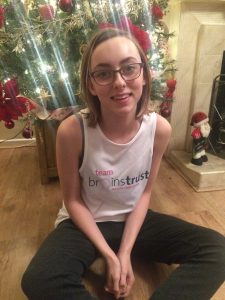This November, 24 fundraising superstars took on brainstrust’s brand new Run, Row, Ride challenge to complete 30 miles in 30 days, collectively raising nearly £5,000.00!
They may have signed up alone, but they came together for the same reason; to help support the 30 people every day in the UK who hear the life changing words ‘you have a brain tumour’.
Showing incredible determination and unwavering enthusiasm they smashed their targets and for some individuals, even rediscovered a love for being active and having a reason to train. For many, this was a very personal journey having themselves either received support from brainstrust or witnessed it’s impact on a loved one.
A few of our participants reflect below on their own experience with this challenge:

AMY (Pictured right) – “This time last year I discovered I had a brain tumour and within days I was facing a 6 hour op to remove it. I took on this challenge as I would never have thought I’d be able to do it just one year after my diagnosis. One of the many reasons I am where I am now is because of charities like brainstrust helping people like me by providing support and much needed information to help get through the dark times. The challenge itself was great and the reason for doing it spurred me on to do as many miles as possible! I need a lot of willpower to get myself in the gym so this was the perfect excuse. ”
MARGARET (Pictured right) – ‘I am so pleased that I decided to take on this challenge, my confidence in my ability to complete a mile a day for 30 days has increased immeasurably. I smile constantly, feel six inches taller and my sponsorship over on my Just Giving page will hopefully mean that many more brain boxes will be available for those who need them’.
LAURA (Pictured left) – I lost my mum to an astrocytoma brain tumour in November 2015. She was diagnosed about 18 months earlier and had an operation, but she lost the use of her right side. She fought it and started walking again but it kept coming back. My sons lost their Nana far too young. I got my old mountain bike out of the garage and started cycling just to give me some head space and a bit of exercise. I got fitter and began cycling further so I bought myself a new gravel bike this summer. I wanted a cycling challenge to give me something to train for and I found run, row, ride! I completed my ride on Nov 10th, I ended up doing 38 miles due to my dodgy map reading but I was home within daylight so all fine! I was really pleased with myself as it was the first time I had cycled so far, the furthest I had done before was about 25 miles years ago and before I had children! I need to find a new challenge for next year now!
NATASHA – (Pictured right) – My mum was diagnosed with an inoperable brain tumour 5 years ago and it changed family life. brainstrust helped us as a family learn to cope and help each other, so when I saw this challenge I knew it was my chance to give something back so they could continue helping others! It helped towards my D of E Bronze award, physical training which is Triathlon via air cadets too, so win, win!
SARAH – “When I saw that brainstrust were doing the 30 miles in 30 days challenge I thought it was a perfect time to take on my own challenge, not only to do it as part of my rehabilitation but to help raise funds to say Thank you for the fantastic support I have received and still do. I was so pleased to complete it only 12 months after my brain surgery and while some of the miles were tough they were all worth it”












